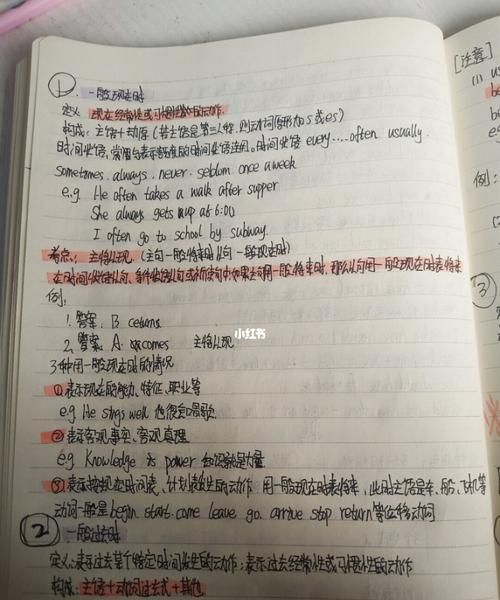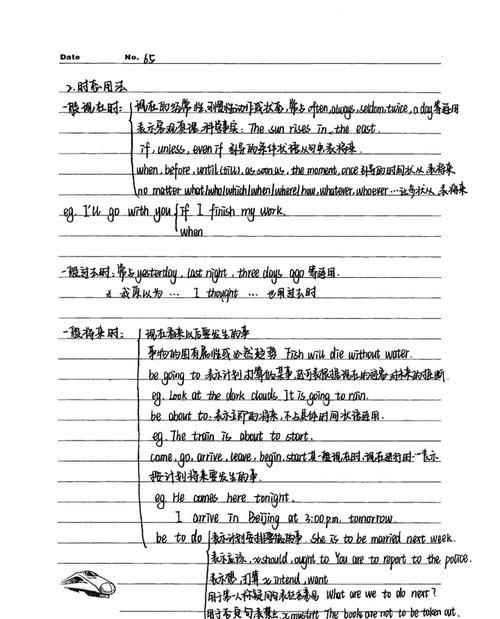本文目录
80词左右的英语读书笔记
Yesterday, I read a book, the name of the book is《Dr Bethune》. Dr Bethune was a famous doctor From Canada. In 1938, he came to China. At that time , China was at war with Japan. He worked as a doctor in the Chinese army and saved many soldiers’ lives. He worked very hard and became sick. Dr Bethune died in 1939. He was only 49 years old. He was a good man and we remember him today. I think the book is very, very good!

初中英语八大时态笔记图片
1.一般现在时:
主语+do/does
e.g
We
clean
the
room
every
day.
2.一般过去时:
主语+did
e.g
We
cleaned
the
room
just
now.
3.现在进行时:
主语+am/is/are
doing
e.g
We
are
cleaning
the
room
now.
4.过去进行时:
was/were
doing
e.g
We
were
cheaning
the
room
at
5:00
yesterday
afternoon.
5.现在完成时:
have/has
done
e.g
We
have
cleaned
the
room
already.
6.过去完成时:
had
done
e.g
We
had
cleaned
the
room
before
he
arrived.
7.一般将来时:
will
do/
e.g
We
will
clean
the
room
tomorrow.
8.过去将来时:
was/were
to
/would
do
e.g
He
said
he
would
clean
the
room
next.

有关英语时态的思维导图
一. 时态:
一般现在时,现在进行时,一般过去时,现在完成时,一般将来时,过去进行时,过去完成时,过去将来时
1. 一般现在时
表示一般性,经常性的动作或一般性事实。
u 含有be动词的句子
He is a teacher.
The girl is very beautiful.
Tim and Jack are students.
★变疑问句将be动词移到句首
Is he a teacher?
Is the girl very beautiful?
Are Tim and Jack students?
★变否定句在be动词后面加not
He is not a teacher.
The girl is not very beautiful.
Tim and Jack are not students.
★肯定回答及否定回答
Yes, he is. No, he is not.
Yes, she is. No, she is not.
Yes, they are. No, they are not.
u 不含有动词的句子,即含有一般动词的句子
第三人称单数及单数名词
He likes books.
She likes him.
The dog likes bones.
★变疑问句在句首加does, 动词变为原型
Does he like books?
Does she like him?
Does the dog like bones?
★变否定句在主语及动词之间加doesn’t, 动词变为原型
He doesn’t like books.
She doesn’t like him.
The dog doesn’t like bones.
★肯定回答及否定回答:
Yes, he does. No, he doesn’t.
Yes, she does. No, she doesn’t
Yes, it does. No, it doesn’t.
注意:第三人称单数形式一般在动词后面加S,不要和名词复数混淆,变否定句或疑问句时名词复数没有任何变化。
其他人称及复数名词
I want to have a bath.
We have some meat.
The students like smart teachers.
★变疑问句在句首加do
Do you want to have a bath?
Do we have any meat?
Do the students like smart teachers?
★变否定句在主语和动词之间加don’t.
You don’t want to have a bath.
We don’t have any meat.
The students don’t like smart teachers.
★肯定回答及否定回答
Yes, I do. No, I don’t.
Yes, we do. No, we don’t
Yes, they do. No, they don’t.
2. 现在进行时
表示现在正在进行的动作。
构成: 主语+be动词+动词的现在分词+其它成分(现在分词的构成见附录)
We are having lunch.
He is reading a book.
The dog is running after a cat.
The boys are swimming across the river.
★变疑问句将be动词移到句首
Are we having lunch?
Is he reading a book?
Is the dog running after a cat?
Are the boys swimming across the river?
★变否定句在be动词后面加 not
We are not having lunch.
He is not reading a book.
The dog is not running after a cat.
The boys are swimming across the river.
★特殊疑问句:what, which, how, where, who, etc.
疑问词+动词+主语+现在分词
What are you doing?
What is she doing?
What is the dog doing?
(必背)
没有进行时的动词
表示状态,思想,感情和感觉的动词不能表示正在进行的动作
1. 表示感觉,感官的词
see, hear, like, love, want,
2. have, has当”拥有”讲时没有进行时
3. 一般过去时
表示过去发生的动作或事件, 常和表示过去的时间状语连用,如yesterday, last night, the day before yesterday, 3 days ago,
含有be动词的句子, 将动词变为过去式,am, is的过去式为was,are的过去式为were
I was at the butcher’s.
You were a student a year ago.
The teacher was very beautiful ten years ago.
★变疑问句将be动词移动到句首
Were you at the butcher’s?
Were you a student a year ago?
Was the teacher very beautiful ten years ago?
★变否定句在be动词后面加not
I was not at the butcher’s.
You were not a student a year ago.
The teacher was not very beautiful ten years ago.
★肯定回答否定回答
Yes, I was. No, I was not.
Yes, you were. No, you were not.
Yes, he/she was. No, he/she was not.
★特殊疑问句:
What did you do?
(必背)
不含有be动词的句子,将动词变为过去式,动词过去式构成见附录
I finished my homework yesterday.
The boy went to a restaurant.
The Sawyers lived at King Street a year ago.
★变疑问句在句首加did, 动词变为原型
Did you finish your homework yesterday?
Did the boy go to a restaurant?
Did the Sawyers live at King Street a year ago?
★变否定句在主语和动词之间加did not
I did not finish my homework yesterday.
The boy did not go to a restaurant.
The Sawyers did not live at King Street a year ago.
★肯定回答及否定回答
Yes, I did. No, I didn’t.
Yes, he did. No, he didn’t.
Yes, they did. No, they did not.
4. 现在完成时
构成:主语+助动词have, has+过去分词
用法:
1) 表示过去发生的和现在有某种联系的动作,常和just, usually, already, since等时间副词连用
I have just had lunch. (饱了,不用再吃了)
He has had a cup of tea.(不渴了,不用再喝)
They have already had their holiday. (不能再度假了)
The boy has already read the book. (已经知道书的内容了,不用再看了)
2) 询问别人是否做过某事一般用现在完成时:
Have you finished your homework?
Have you been to Beijing?
Have he seen the film?
3) 表示开始于过去并持续到现在的动作
I have lived in Beijing for twenty years.
I have worked for this school for 1 year.
4) 表示一种经历,经验:去过…地方,做过…事情,经历过…事情
I have never had a bath.
I have never seen a film.
I have never been to cinema.
I have ever been to Paris.
Have been to表示去过,have gone to 表示去了
I have been to London.(人已经回来)
He has gone to London.(人还在那里)
5) 表示一种结果, 一般不和时间副词联用
I have lost my pen.
I have hurt myself.
He has become a teacher.
She has broken my heart.
句型变化:
★变疑问句将助动词移到句首,变否定句在助动词后面加not.
e.g. Have you lost your pen? I have not lost my pen.
★肯定回答及否定回答
Yes, I have. No, I have not.
★特殊疑问句:
What have you done?
What has he done?
一般过去时与现在完成时的区别:
凡是有明确的表示过去的时间状语的句子为过去时
注意:有些动词表示的动作有一个终点,不能再延续,因此不能和表示一段时间状语连用
错:I’ve left Beijing for 3 days.
对:I left Beijing 3 days ago. I have been away from being for 3 days.
5. 一般将来时
表示将来将要发生的动作, 经常和tomorrow, next year, the day after tomorrow, the year after the next, in five hours’ time, etc. 表示将来的词联用
结构: 主语+助动词will+动词原形
I will go to America tomorrow.
The pilot will fly to Japan the month after the next.
Jack will move into his new house tomorrow morning.
★变疑问句将助动词移到句首
Will you go to America tomorrow?
Will the pilot fly to Japan the month after the next?
Will Jack move into his new house tomorrow morning?
★变否定句在助动词后面加not
I will not go to America tomorrow.
The pilot will not fly to Japan the month after the next.
Jack will not move into his new house tomorrow morning
★肯定回答及否定回答
Yes, I will. No, I will not.
Yes, he/she will. No, he/she will not.
Yes, he will. No, he will not.
★特殊疑问句:
What will you do?
6. 过去完成时:
用法:在过去的时间里,两个动作中,发生在前的哪个动作要用过去完成时。
结构:had+过去分词
After she had finished her homework, she went shopping.
They had sold the car before I asked the price.
The train had left before I arrived at the station.
After/before引导的时间状语从句放在句首要在句子后面加逗号,如果放在主句后则不用加。
★ 变疑问句将助动词移到句首
Had she finished her homework?
★ 变否定句在助动词后面加not
She hadn’t finished her homework.
★ 肯定回答及否定回答
Yes, she had. No, she hadn’t.
★ 特殊疑问句:
What had she done?
7. 过去进行时
表示过去正在进行的动作,经常用在when, while, as引导的状语从句中。
结构:was/were+doing
When my husband was going into the dining room this morning, he dropped some coins on the floor.
While we were having dinner, my father was watching TV.
8. 过去将来时
结构:would do
She said she would go here the next morning.
二. 特殊句型:there be 句型,be going to 结构
1. Be going to 结构
表示打算,准备,计划做某事
★结构:主语+be动词+going to +动词原型
I am going to make a bookcase.
They are going to paint it.
The father is going to give the bookcase to his daughter.
★变疑问句将be动词移到句首
Are you going to make a bookcase?
Are they going to paint it?
Is the father going to give the bookcase to his daughter?
★变否定句在be动词后面加not
I am not going to make a bookcase.
They are going to paint it.
The father is not going to give the bookcase to his daughter.
★肯定回答及否定回答
Yes, I am. No, I am not.
Yes, they are. No, they are not.
Yes, he is. No, he is not.
★特殊疑问句
What are you going to do?
What are they going to do?
What is the father going to do?
(必背)
2. There be 句型
表示哪里有什么东西(某处有某物)
u There is+单数名词+表示场所的词(一般为介词词组)
There is a book in this room.
There is a pen on the table
u There are+复数名词+表示场所的词(一般为介词词组)
There are two pens on the table.
There are three schools there.
★变疑问句将be动词移到句首
Is there a book in this room?
Are there two pens on the table?
★变否定句在动词后面加not
There is not a book in this room.
There are not two pens on the table.
★肯定回答及否定回答
Yes, there is. No, there is not.
Yes, there are. No, there are not.
三. 问句:
一般疑问句,特殊疑问句,选择疑问句,反意疑问句,选择疑问句,否定疑问句
² 一般疑问句: 助动词/be动词+主语
Are you a teacher? Do you want to have a cup of tea?
² 特殊疑问句: 特殊疑问词+一般疑问句
What is your name?
² 选择疑问句: or
Do you want beef or lamb?
² 反意疑问句: 肯定陈述句+否定疑问部分, 否定陈述部分+肯定疑问部分
You don’t need that pen, do you?
² 否定疑问句: 一般疑问句+否定词
Aren’t you lucky? Don’t you want have a rest?
四. 冠词用法:a/an/the的一般用法
详细见笔记
五. 限定词:some, any, many, much
² some, any 修饰可数名词或不可数名词,some用于肯定句,any用于否定句和疑问句,注意,当期待对方的答案为肯定回答时用some
² many修饰可数名词,much修饰不可数名词,在口语中表示很多一般不用many, much, 而用a lot of, 在否定句中表示很多用many, much.
I have a lot of money. I don’t have much money.
六. 名词:种类,复数,名词所有格
1.名词分为可数名词和不可数名词
² 不可数名词
无法分开的东西:water, tea, bread, milk, rice(米)
抽象的东西:love, beauty, coldness(寒冷)
不可数名词有以下特点:
l 不能用a, an修饰
l 不能加s
l 和单数be动词或动词搭配
² 可数名词:
单数可数名词要用冠词修饰,复数可数名词要在名词后面加s,名词复数共有以下几种变化:
规则变化的名词复数形式
规则1
一般情况+s
e.g. shell→shells book→books
规则2
以s, x, ch, sh结尾+es
e.g. fox→foxes church→churches, bus→buses, watch→watches
规则3
以o结尾+s或+es
e.g. potato→potatoes, Negro→Negroes, hero→heroes, tomato→tomatoes,(口诀:黑人英雄爱吃土豆和西红柿),剩下一般加s, radio→radios
规则4
以f, fe结尾的,变f, fe为ves
e.g. life→lives half→halves, shelf→shelves, city→cities, wife→wives
规则5
以辅音字母+y结尾, 变y为i+es
e.g. sky→skies fly→flies
不规则变化的名词复数形式
单数
man
woman
foot
goose
tooth
复数
men
women
feet
geese
teeth
单数
child
sheep
deer
mouse
fish
复数
children
sheep
deer
mice
fish
七. 介词( 注意总结书上词组)
八.副词:用法及形容词变副词的变化
u 副词可以修饰形容词,动词,副词或整个句子。如:
The book is very good.
He runs fast.
She came here quite early.
Certainly I will go with you.
u 变化:
1. 直接在形容词后加-ly,
careful-carefully, slow-slowly,
2. 以辅音字母加y结尾的形容词,把y变I, 加-ly,
happy-happily, lucky-luckily
3. 有些词形容词和副词的形式相同,不需要做任何变化
fast, hard, late
4. 有些词加上-ly后意思与原词相差很远:
neary-nearly, high-highly, late-lately,
九. 情态动词的使用:can, must, may, might, need,
1.情态动词can(能够), must(必须), may(可以)
结构:主语+can/must/may+动词原型
He can make the tea.
Sally can air the room.
We can speak English.
★变疑问句将情态动词移到句首
Can he make the tea?
Can Sally air the room?
Can we speak English?
★变否定句在情态动词后面加not
He cannot make the tea.
Sally cannot air the room.
We cannot speak English.
★肯定回答及否定回答
Yes, he can. No, he cannot.
Yes, she can. No, she cannot.
Yes, we can. No, we cannot.
★特殊疑问句:
What can you do?
(必背)
注意:情态动词的句子没有第三人称单数的变化,不要在情态动词或动词后面加S。
2.Must/have to的区别
must 表示必须,是主观上觉得应该做,have to是不得不,是由于客观条件逼迫的必要要做
must 只能用在表示现在和将来的句子里,而have to do可以用在任何时态
3.must, may, might表示猜测:
u must do 表示对现在事实的猜测
u must have done表示对过去事实的猜测
u must have been doing 表示对过去正在进行的事实的猜测
u may/might do, may/might have done表示没有任何事实依据的猜测,might的可能性更小。
u can’t/couldn’t 表示不可能
4.need 用法:
u 表示“需要”时为实意动词,后面可以加名词,也可以加不定式:
I need a pen. Do you need any beer? No, I don’t.
I need to have a rest.
u Need doing=need to be done,表示被动
The flowers need watering.
u Need在否定时做情态动词使用
You needn’t go so early. =You don’t need to go so early.
Must I clean the desk right now? No, you needn’t.

英语各种时态的笔记
给你介绍本书吧
无敌系列的 英语语法
讲得比较浅显,范围比较广

以上就是关于英语时态笔记 ,80词左右的英语读书笔记的全部内容,以及英语时态笔记 的相关内容,希望能够帮到您。

